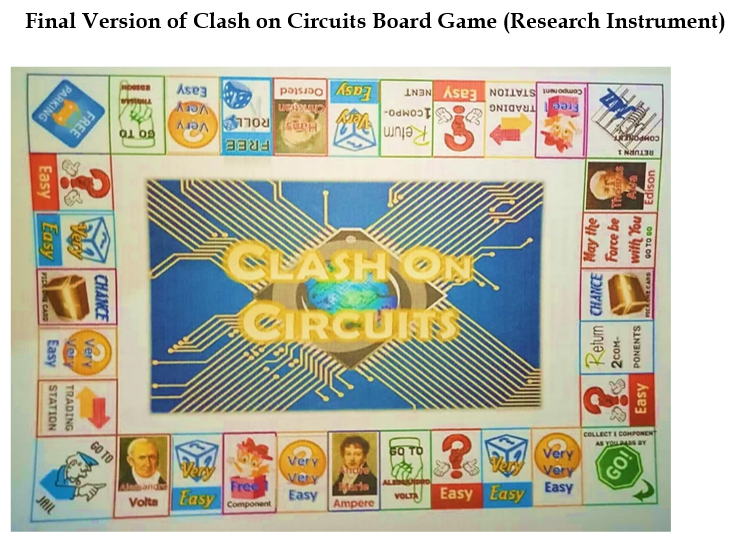A Dual Development of Board Game and Guided-Inquiry Activity in Teaching Electricity for Grade 5
Main Article Content
Abstract
The topic on circuits contained abundant misconceptions and there is a need to devise a teaching modality that will possibly address these misconceptions. The way of rectifying misconceptions should be n ways that engender high student engagement and facilitate accommodation of higher order learning and thinking skills. This research sought to develop a two-pronged modality to address both ICT-enabled classrooms and non-ICT enabled ones. A PhET-based laboratory activity and a board game named “Clash on Circuits” were developed and tried on two different public schools to see if an increment of performance can be observed. Eight (8) in-service teachers and four (4) pre-service teachers assessed the laboratory activity using an adapted analytic rubric, while the board game was tried out with selected students for applicability. In the development of the PhET-based laboratory activity and board game Clash on Circuits, the following were gathered: 1) The readability of the final draft of the PhET-based laboratory activity yielded an average of 78.43 Flesch Reading Ease score and 4.6 Flesch Kincaid grade level; (2) Evaluation of in-service to the developed PhEt-based laboratory activity rated the developed laboratory activity as 8.825 in the average which is exemplary and pre-service teachers rated the developed activity as 9.10 in the average which is also exemplary; (3) The readability of the Final Version of the designed board game has 76.2 Flesch Reading Ease score and 6.8 Flesch Kincaid grade level; (4) Evaluation of the in-service rated the developed board game as 3.75 in the average which is exemplary and preservice teachers rated the developed board game as 3.76 in the average which is exemplary; (5) The difference in the pretest and posttest was significant in S1 school implemented with designed board game, and there is no significant difference in the S2 school implemented with both PhET-based laboratory activity and designed board game; and (6) the respondents’ perceptions from both schools S1 and S2 towards the developed laboratory activity and board game was 5.94 and 6.08 respectively, which was relatively too high and has very positive implication.
Article Details

This work is licensed under a Creative Commons Attribution-NonCommercial-NoDerivatives 4.0 International License.
References
American Association of Physics Teachers. (2015). Role of Labs in High School Physics. Retrieved from: http://www.aapt.org/Resources/policy/roleoflabs.cfm
Duit, R. & von Rhoneck, C. (1998). APRENDIZAGEM E COMPREENSÃO DE CONCEITOS CHAVE EM ELETRICIDADE. International Commission on Physics Education.
Finkelstein, N. D., Adams, W.K., Keller, C.J., Kohl, P.B., Perkins, K.K., Podolefsky, N.S., Reid, S., & LeMaster. R. (2005). When Learning About the Real World Is Better Done Virtually: A Study Of Substituting Computer Simulations For Laboratory Equipment. Phys. Rev. ST Phys. Educ. Res. 1, 010103. Retrieved from: http://journals.aps.org/prstper/abstract/10.1103/PhysRevSTPER.1.010103.
Fonseca, D. M. (2014). Relationship between student profile, tool use, participation, and academic performance with the use of Augmented Reality technology for visualized architecture models. Computers in Human Behavior, 434-445.
Fredette, N. & Lochhead, J. Student conceptions of simple circuits. (1980). The Physics Teacher 18, 194
Keller, C. J., Finkelstein, N.D., Perkins, K.K., & Pollock, S.J. (2007). Assessing the Effectiveness of a Computer Simulation in Introductory Undergraduate Environments. AIP Conf. Proc. 883, 121; Syracuse, New York. doi.org/10.1063/1.2508 707.
Liegeois & Mullet (2002). High School Students’ Understanding of Resistance in Simple Series Electric Circuits. International Journal of Science Education, 551-564.
Moore, E. B., Herzo, T. A., & Perkins, K.K. (2013). Interactive Simulations as Implicit Support For Guided-Inquiry. This article is part of themed collection: The Application of Technology to Enhance Chemistry Education. doi: 10.1039/C3RP20157K http://pubs.rsc.org/en/Content/ArticleLanding/2013/RP/C3RP20157K
Ohio State University. (2010). Computer simulations can be as effective as direct observation at teaching students. ScienceDaily. Retrieved on June 13, 2015 from: www.sciencedaily.com/releases/2010/02/100211151653.htm
Özdemir, O., & Işik, H. (2015). Effect of Inquiry-Based Science Activities on Prospective Elementary Teachers‟ Use of Science Process Skills and Inquiry Strategies. Journal of Turkish Science Education, 12(1), 43–56. doi.org/10.12973/tused.10132a PhET Interactive
Simulations. (2015). About PhET. Retrieved from: http://phet.colorado.edu/en/about.
Rehn, D. A., Moore, E. B., Podolefsky, N. S., & Finkelstein, N., JoTLT. (2013). Tools For High-Tech Tool Use: A Framework and Heuristics for Using Interactive Simulations. 2(1), p. 31-55. Retrieved from: http://jotlt.indiana.edu/article/view/3507/.
Ryan, R.M. (2000). Self-determination theory and the facilitation on intrinsic motivation, social development, and well-being. American psychologist.
Scardamalia, M. (2002). Computer Support for Knowledge-Building Communities. The Journal.
Stirling, D. (2013). Games as Educational Tools: Teaching Skills, Transforming Thoughts. Retrieved from: http://infospace.ischool.syr.edu/2013/06/27/games-as - educational-tools-teaching-skills-transfroming-thoughts/
Shaffer,P. S. & McDermott, L. C. (1992). Research as a guide for curriculum development. Depratment of physic, University of Washington.
Thelwell, A. (2015). The Blobz Guide to Electric Circuits. Retrieved from: andythelwell.com: http://www.andythelwell.com/blobz/guide.html
Triona & Klahr (2003). Point and click or grab and heft: Comparing the influence of physical and virtual instructional materials on elementary school students’ ability to design experiments. Cognition and Instruction, 149-173.
Wenham, M. (2001). 200 science investigations for young students: practical activities for science 5-11.
Winsberg, Eric. (2015). "Computer Simulations in Science", The Stanford Encyclopedia of Philosophy (Summer 2015 Edition), Edward N. Zalta (ed.). Retrieved from: http://plato.stanford.edu/archives/sum2015/entries/simulations-science/


